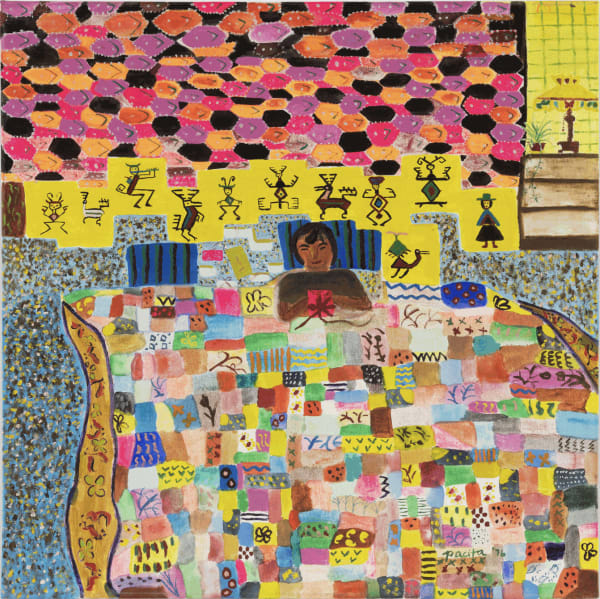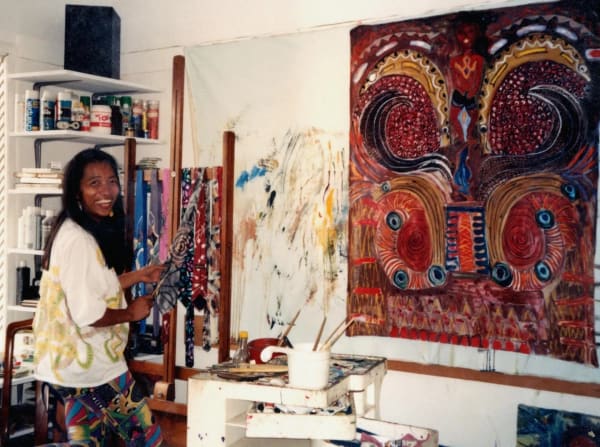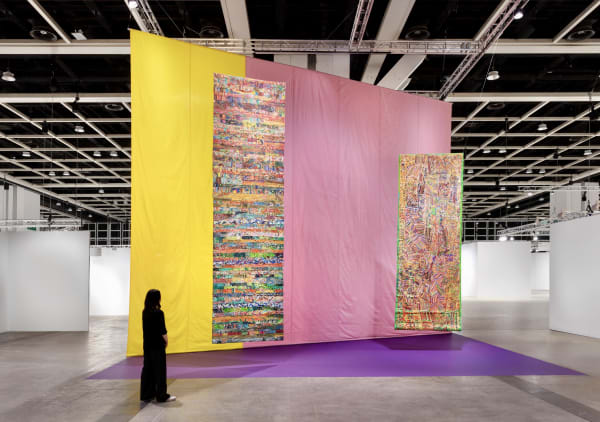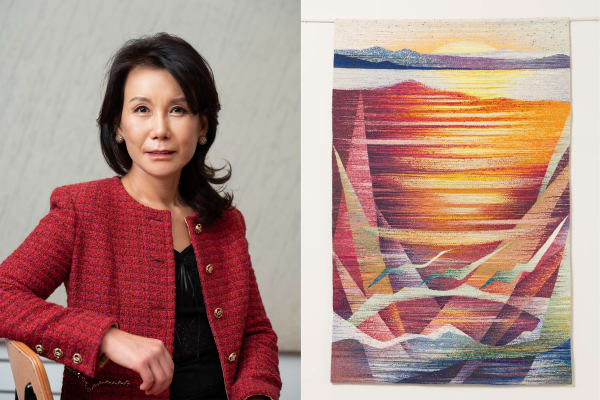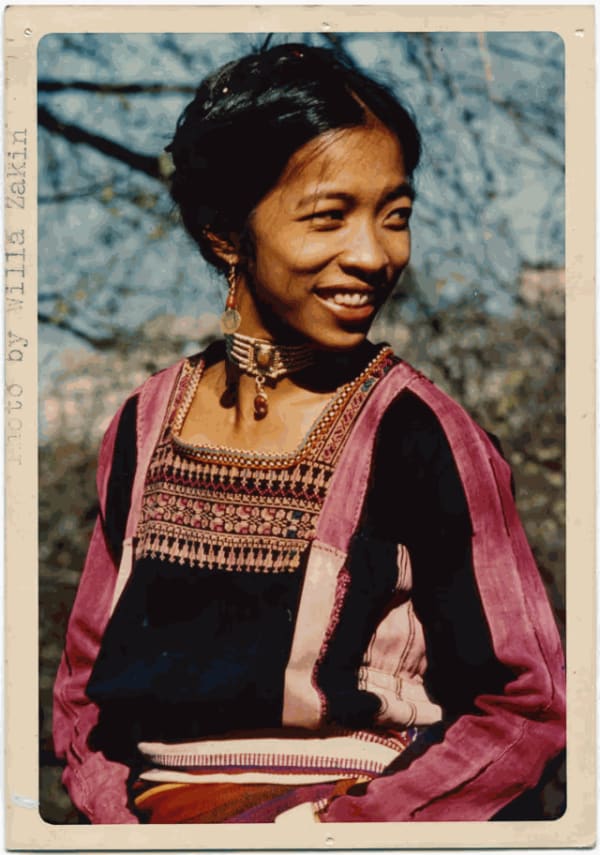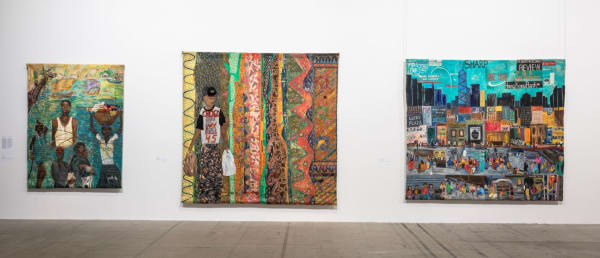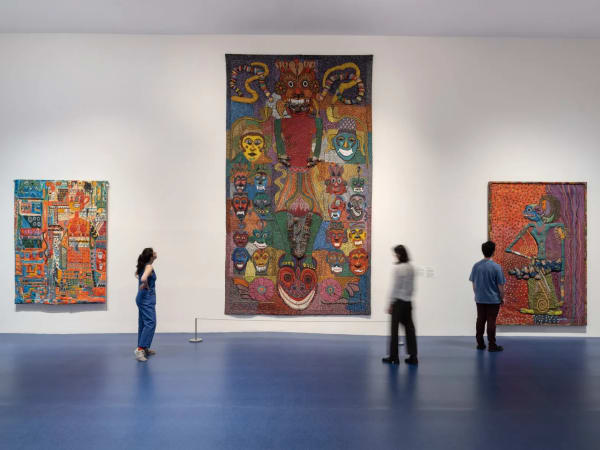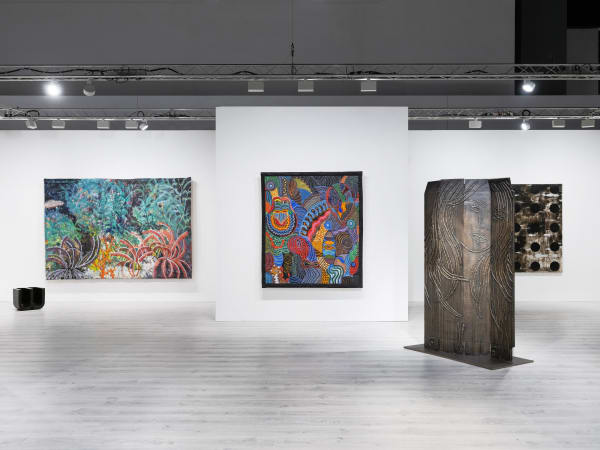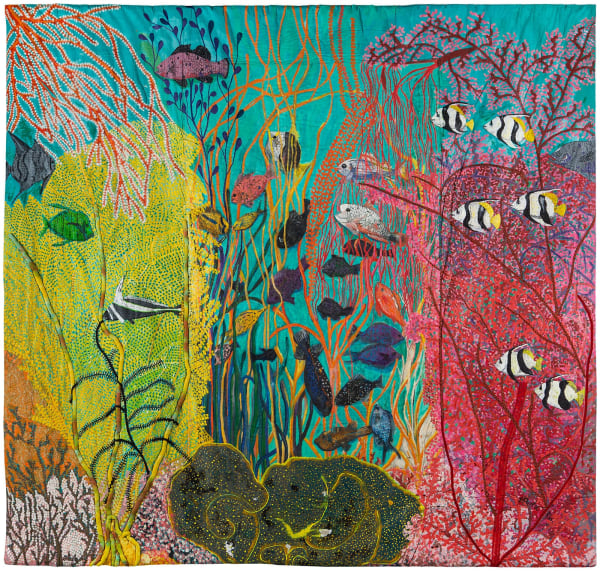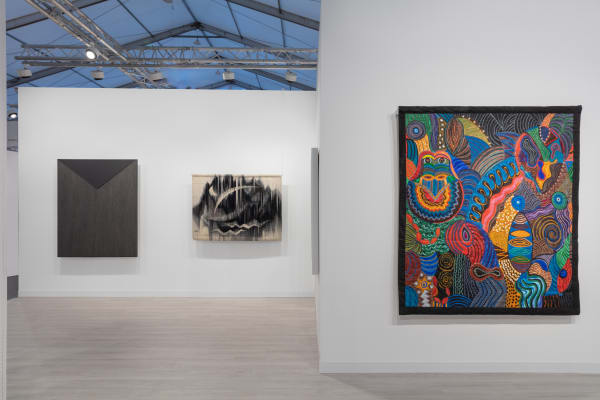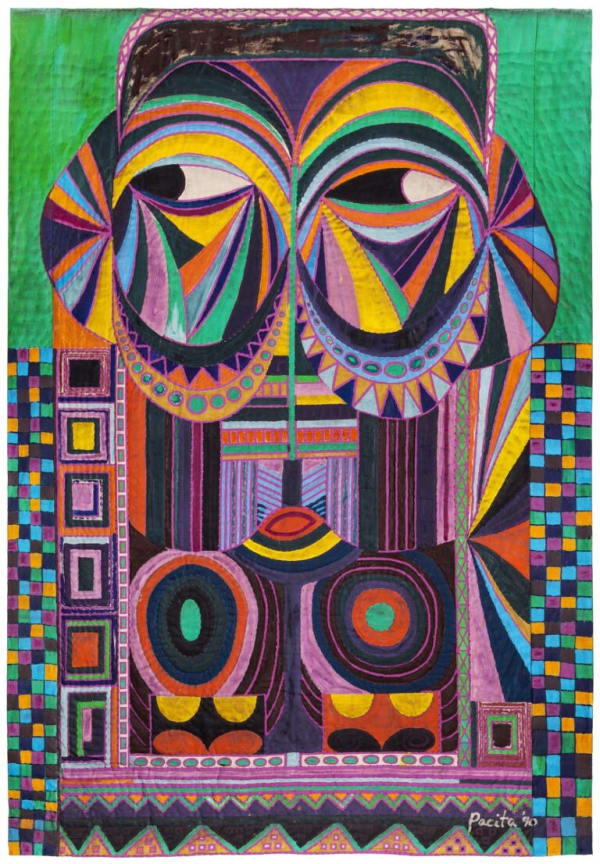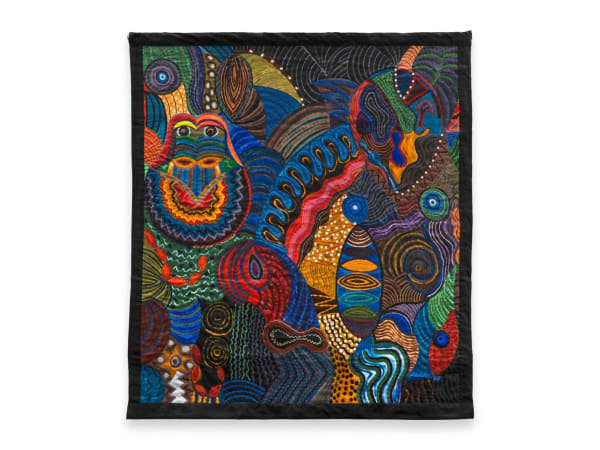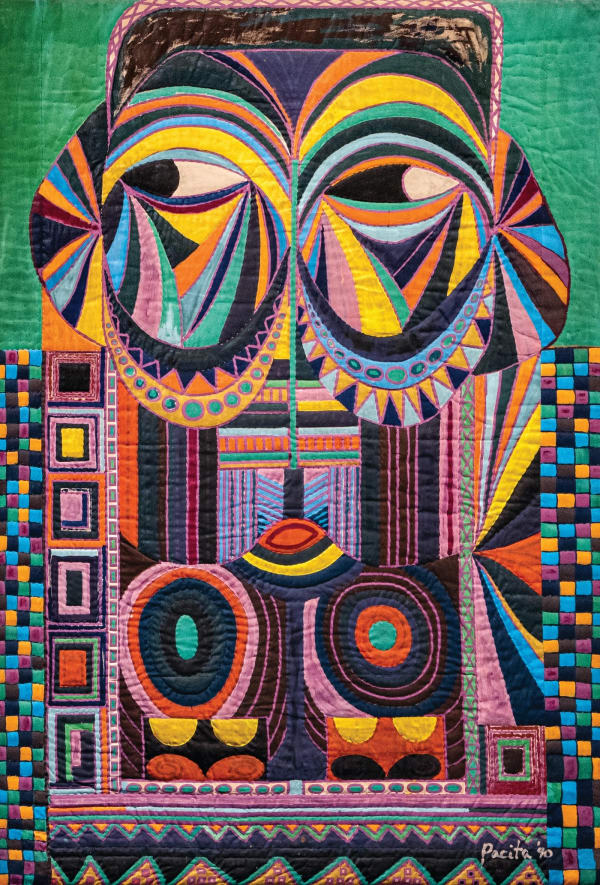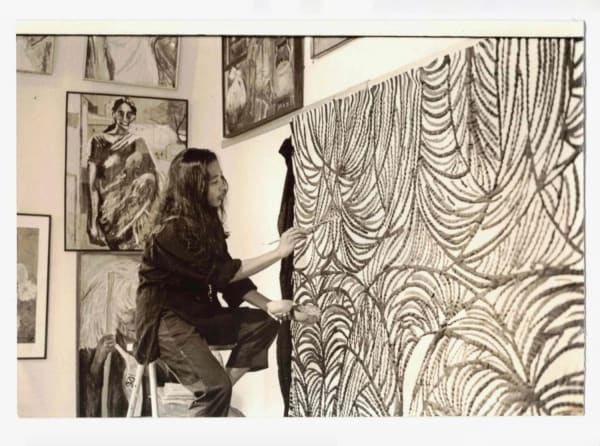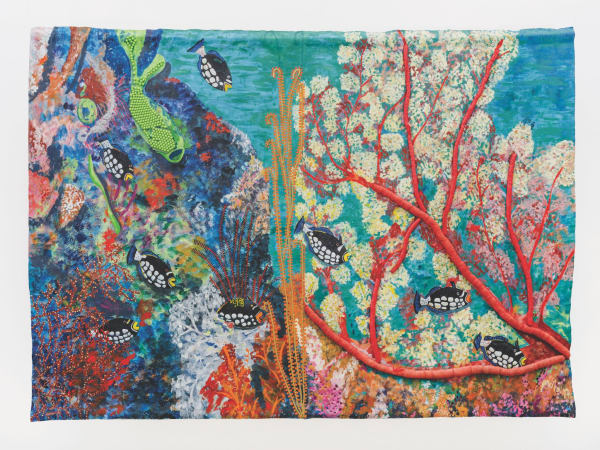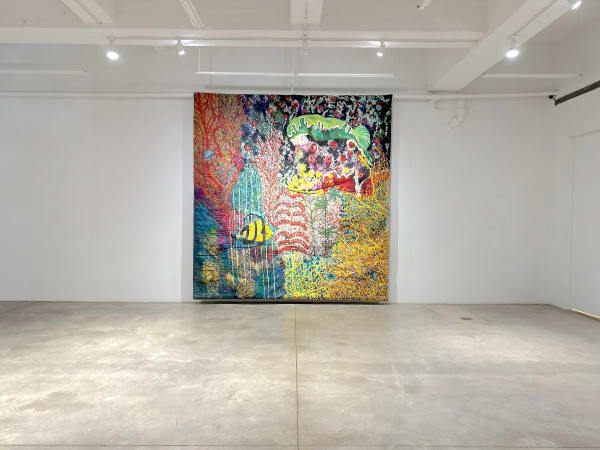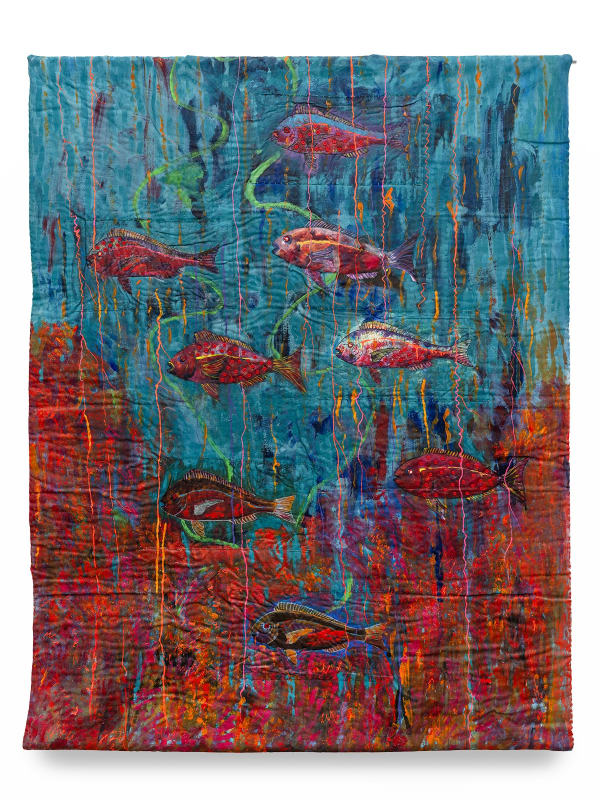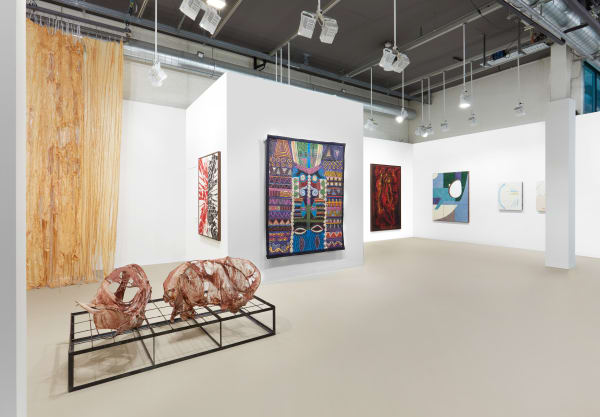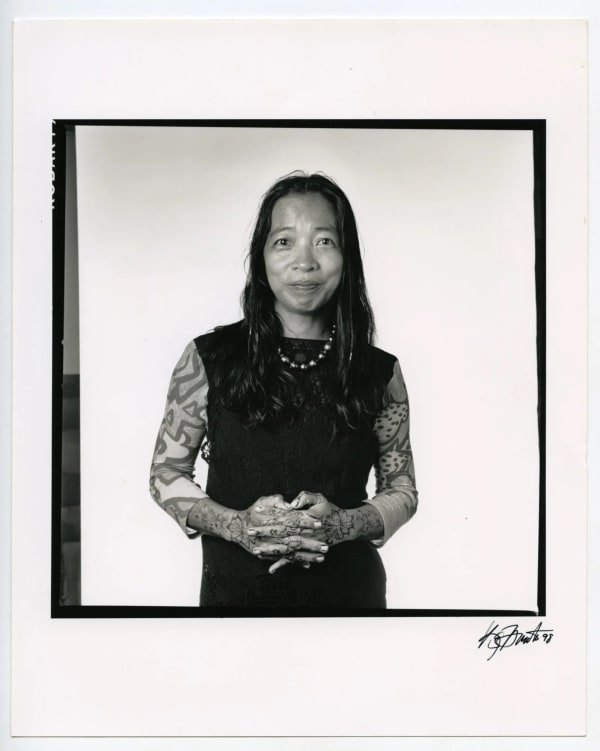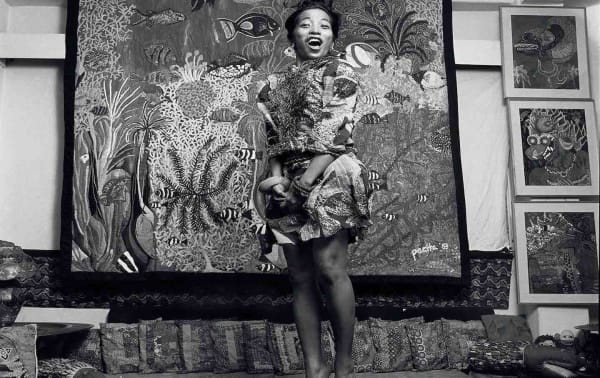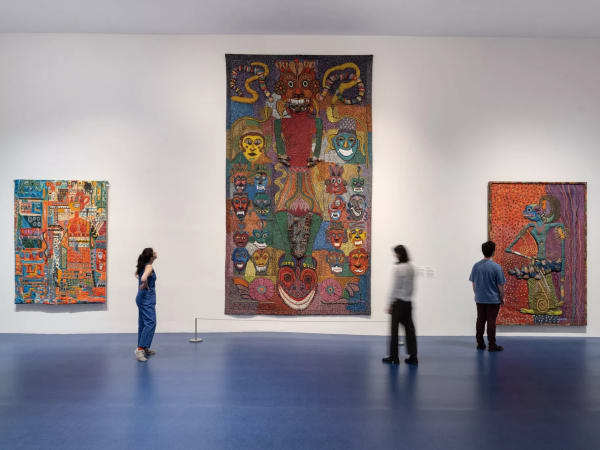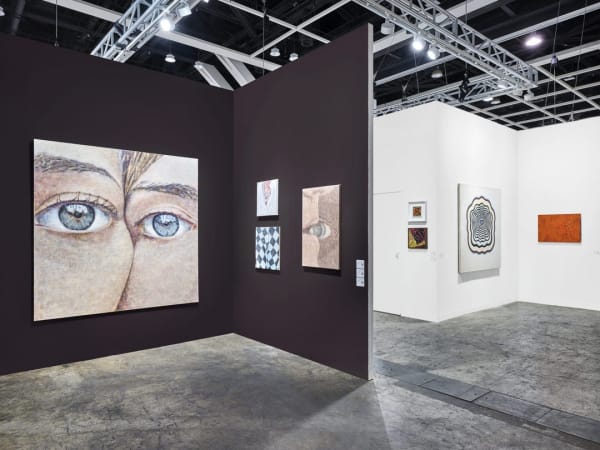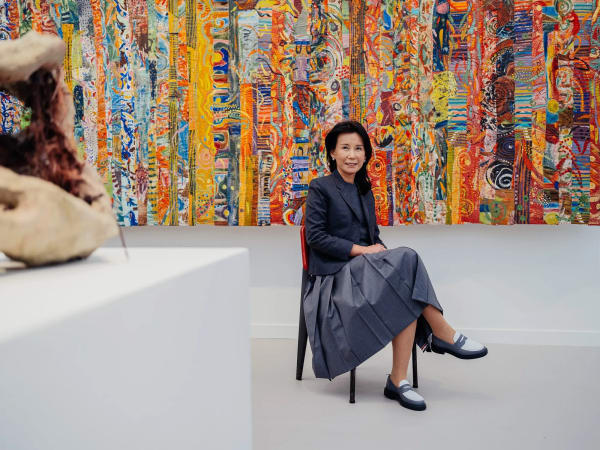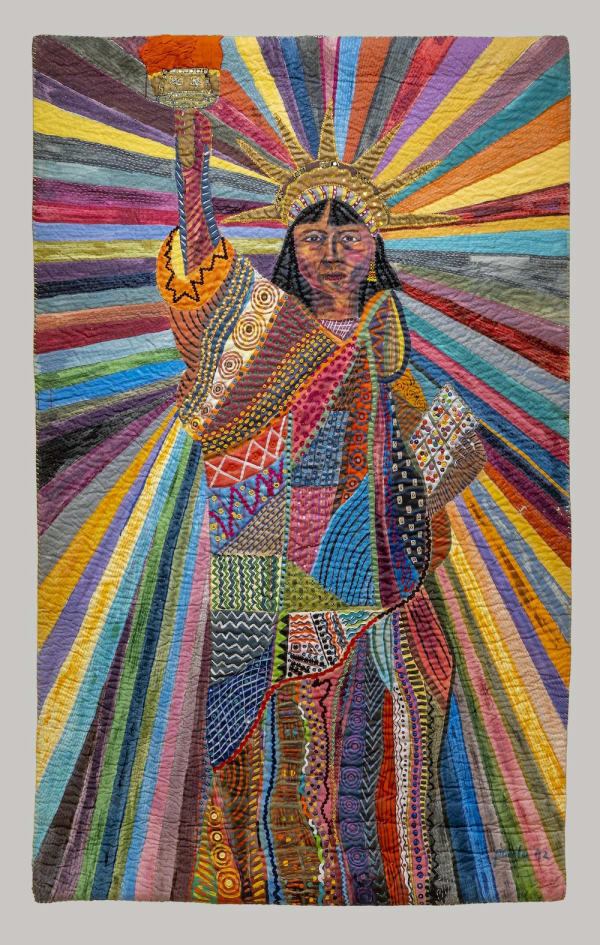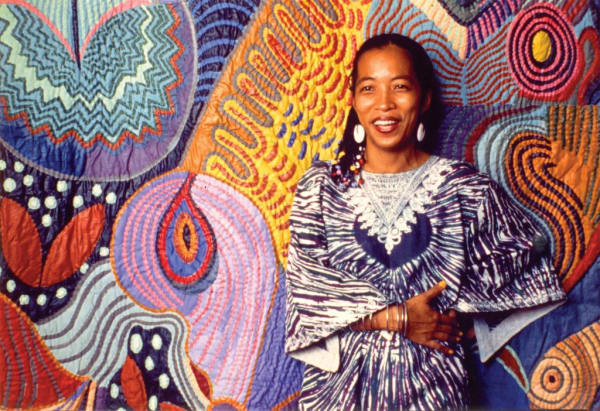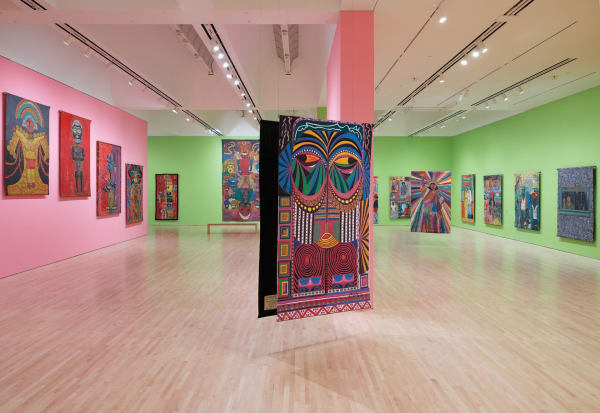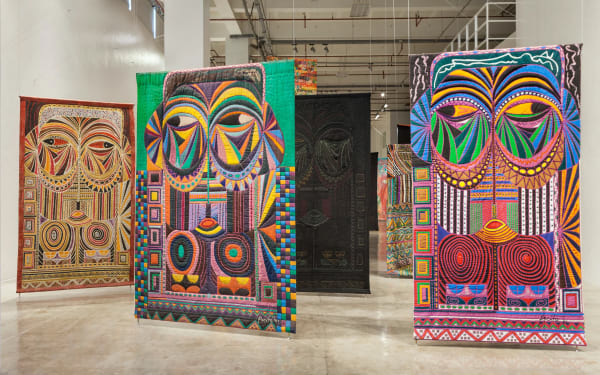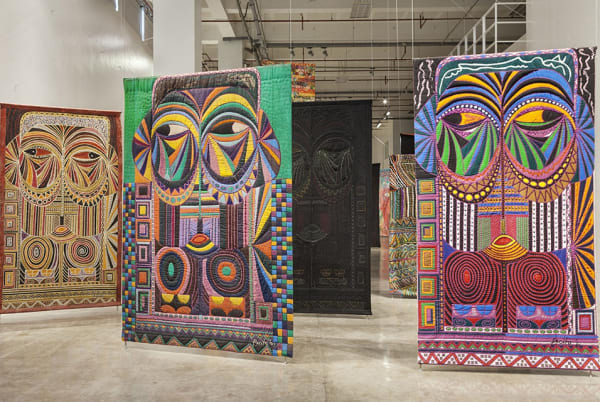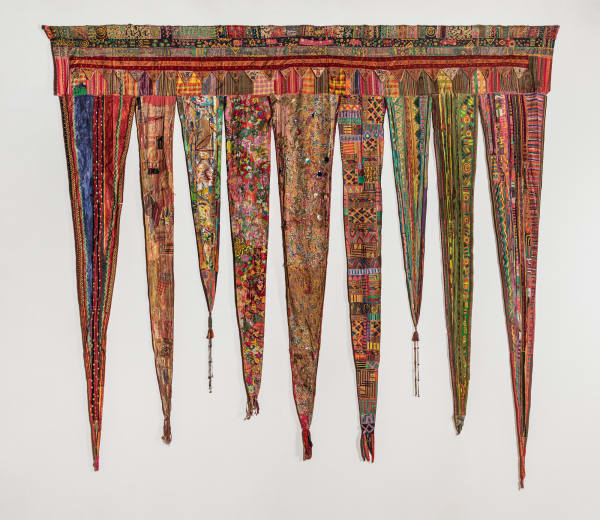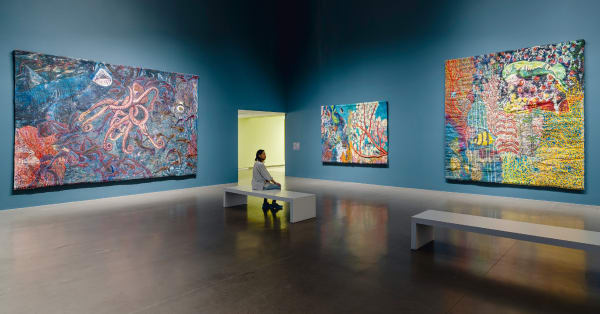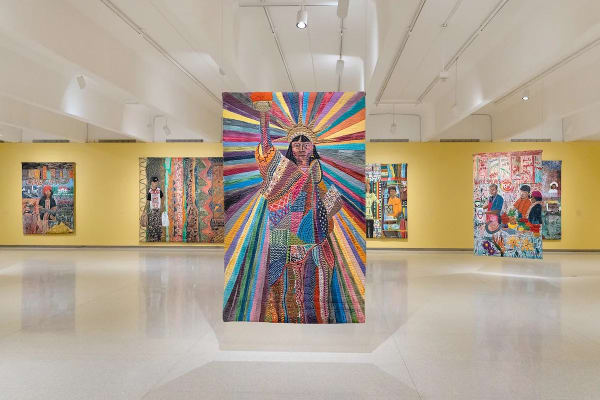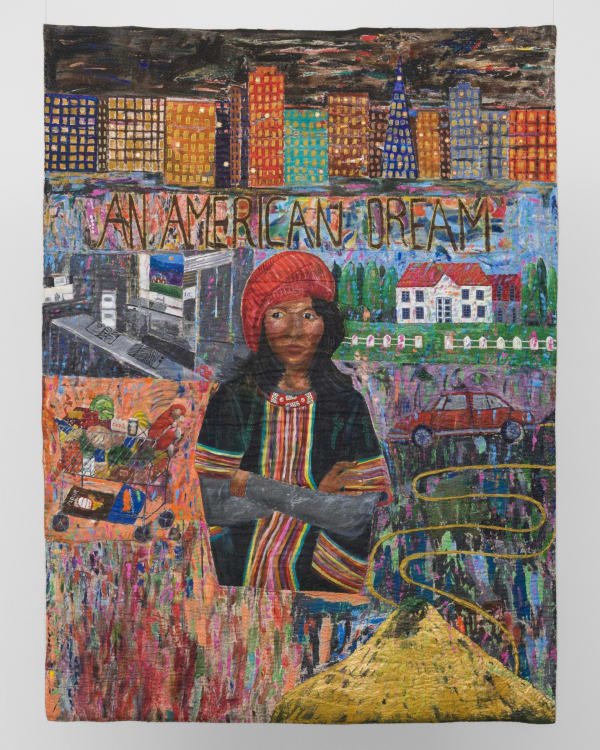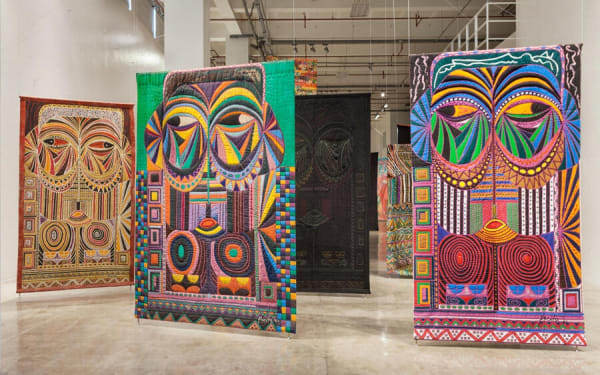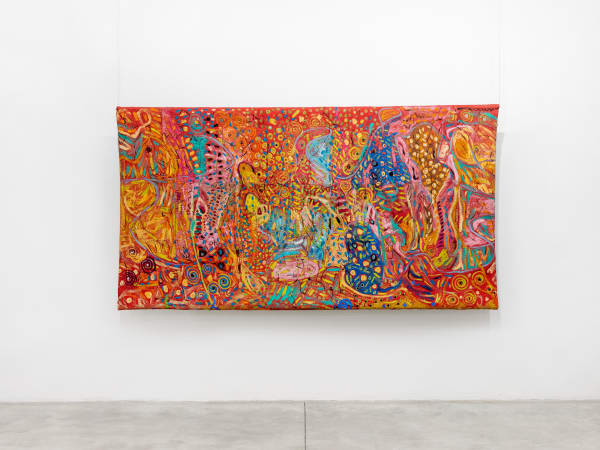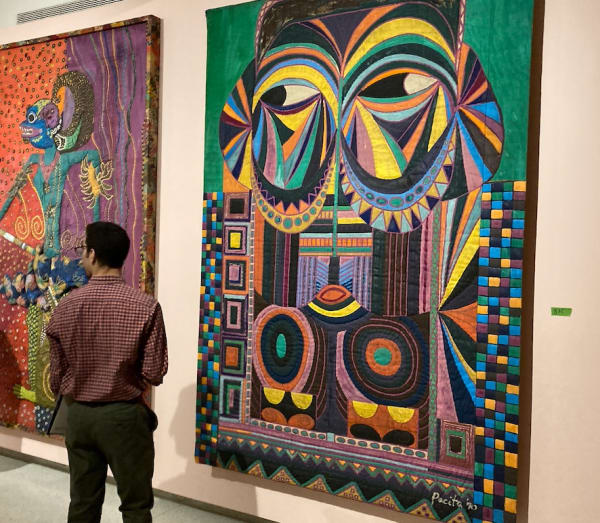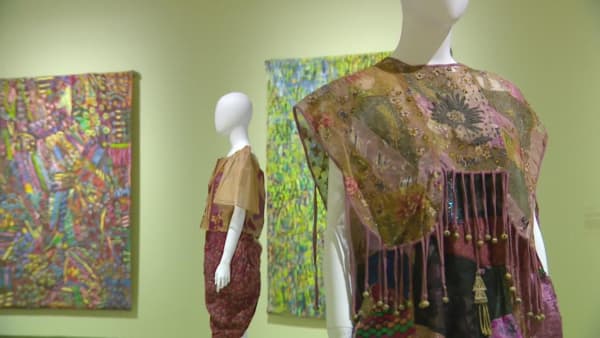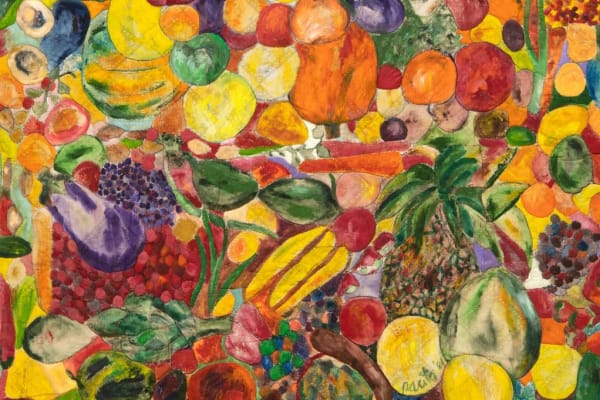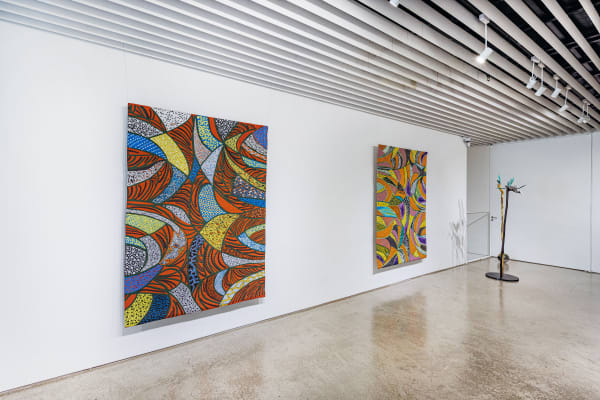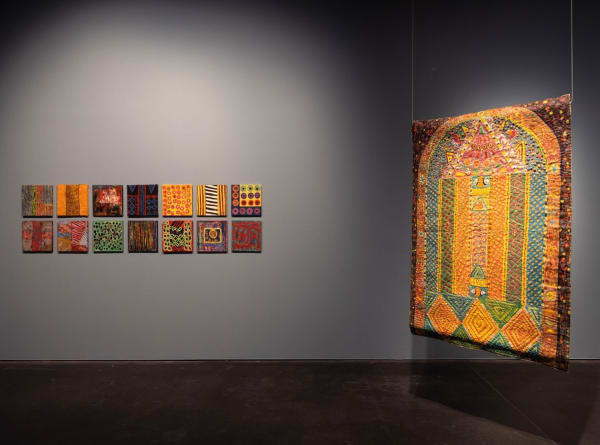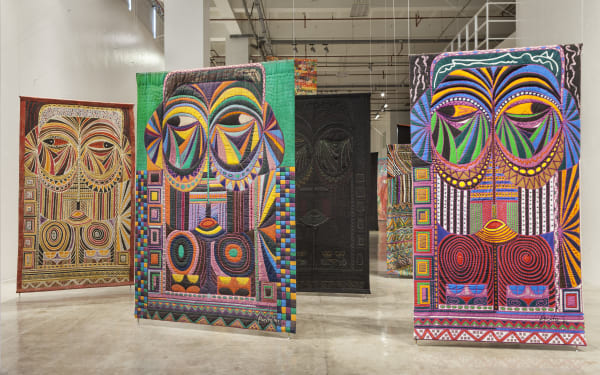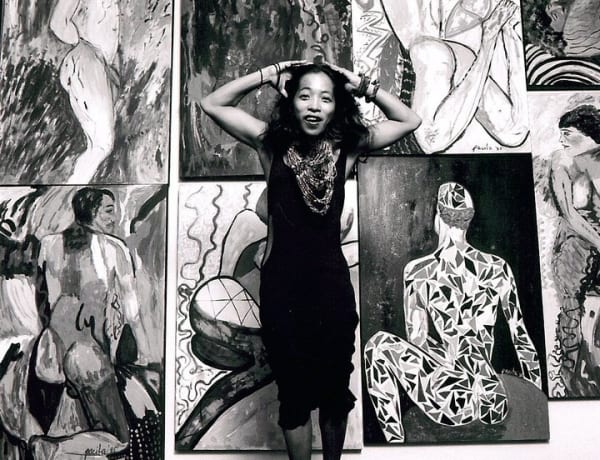Born to a family of politicians and activists in Batanes, the furthermost-north island state in the Philippines, Pacita Abad (1946-2004) was sent to the US to finish her graduate studies after political violence initiated by Ferdinand Marcos put her life in danger. Abad settled in San Francisco in 1970, drawn in by the Summer of Love, and met Jack Garrity a few years later, the two embarking upon a yearlong odyssey across Asia in 1973. While this trip and its myriad multicultural interactions convinced Abad to devote herself to art, it also foreshadowed the itinerant, global lifestyle that would characterize her artistic practice.
Widely defined by her use of color, something she remained adamant about from her early studies, Abad pioneered new forms of materiality in her work, illustrated in one instance by her widely celebrated trapunto paintings, a form of quilted painting the artist originated by stitching and stuffing her painted canvases instead of stretching them over a frame. Her oeuvre featured an immense array of subject matter, from tribal masks and social realist tableaus to lush and intricately rendered underwater scenes and abstractions. Accumulating materials, techniques, and subjects from her vast travels, oftentimes within the same composition, Abad was uniquely positioned to explore modernity's uneven development with the greatest care, as a figure born outside of the metropole. Her work predates contemporary discourses around postcolonial feminisms, globalization and transnationalism, offering an intuitive understanding of the mutability and heritability of traditions in the places she lived.
Her work has been featured in major international exhibitions, including the 11th Berlin Biennale; 13th Gwangju Biennale; 4th Kathmandu Triennale; Asia/America: Identities in Contemporary Asian American Art, a traveling exhibition organized by the Asia Society, New York; Beyond the Border: Art by Recent Immigrants at the Bronx Museum of the Arts; La Segunda Bienal de la Habana, Cuba; and the Second Contemporary Asian Art Show at the Fukuoka Art Museum, Japan. She has also participated in group shows at Haus der Kunst, Tate Liverpool, Para Site (Hong Kong), and the National Gallery Singapore, among many others.
In 2023, the Walker Art Center in Minneapolis organized the first major touring retrospective of Abad’s work, curated by Victoria Sung and spanning her 32-year career. The exhibition traveled to the San Francisco Museum of Modern Art, MoMA PS1 in New York, and the Art Gallery of Ontario in Toronto over the next two years. Her work was also included in the 60th Venice Biennale, Foreigners Everywhere, curated by Adriano Pedrosa—further cementing her posthumous emergence as a defining figure of transnational contemporary art.
Pacita Abad’s works are held in over 45 public collections worldwide, including the Metropolitan Museum of Art, the Museum of Modern Art, the Smithsonian American Art Museum, the Carnegie Museum of Art, SFMOMA, the Hirshhorn, the Walker Art Center, the Cantor Arts Center at Stanford University, Tate Modern, the Guggenheim Abu Dhabi, M+ in Hong Kong, and the National Gallery Singapore. In 2025, Stanford University acquired the Pacita Abad Archives—one of the most significant archival gifts from an Asian American artist—joining landmark holdings alongside Ruth Asawa and Bernice Bing.
Pacita Abad passed away in Singapore in 2004, leaving behind a legacy as a visionary artist who redefined the global contours of contemporary art with color, activism, and radical empathy.
-

Pacita Abad: Philippine Painter
Metropolitan Museum of Manila 28 Nov 2024 - 30 Mar 2025This exhibition celebrates the late artist Pacita Abad (1946-2004) as a Philippine painter. Born in Batanes, the Philippines’ northernmost province, Pacita left the country in 1970, resided in 14 cities,...Learn More -

Pacita Abad | Walter Haefner Foyer
Kunsthaus Zurich 19 Nov 2024 - 1 Jun 2025Trapuntos by Pacita Abad are on view in the Walter Haefner Foyer at the Kunsthaus Zurich. On her extensive travels, Pacita Abad (1946 Batanes, Philippines – 2004 Singapore) found her...Learn More -

Pacita Abad
Art Gallery of Ontario 9 Oct 2024 - 19 Jan 2025A vivid kaleidoscope of color, the first major retrospective dedicated to artist Pacita Abad makes its only Canadian stop at the Art Gallery of Ontario in Toronto. Spanning her 32-year...Learn More -

Unravel—The Power and Politics of Textiles in Art
Stedelijk Museum Amsterdam 14 Sep 2024 - 5 Jan 2025Pacita Abad is featured in Unravel at the Stedelijk Museum Amsterdam, on view through January 5, 2025. In Unravel , artists from around the world present extraordinary artworks, from large-scale,...Learn More -

Connecting Bodies: Asian Women Artists
MMCA Seoul 3 Sep 2024 - 3 Mar 2025Pacita Abad and Mire Lee are featured in Connecting Bodies at the MMCA Seoul. Connecting Bodies: Asian Women Artists attempts a new examination of the contemporary meaning of post‒1960s art...Learn More -

Pacita Abad
Underwater Wilderness 27 Jun - 16 Aug 2024Learn More -

Foreigners Everywhere (featuring Pacita Abad)
60th Venice Biennale 20 Apr - 24 Nov 2024The 60th International Art Exhibition of La Biennale di Venezia, titled Stranieri Ovunque - Foreigners Everywhere, will open to the public on Saturday, April 20 at the Venice Giardini. Pacita...Learn More -

When You See Me: Visibility in Contemporary Art/History
Dallas Museum of Art 7 Apr 2024 - 13 Apr 2025How Mali Lost Her Accent from Pacita Abad's 'Immigrant Experience' series is featured in When You See Me at the Dallas Museum of Art. Explore the complexities of visibility in...Learn More -

Pacita Abad
MoMA PS1 4 Apr - 2 Sep 2024The first retrospective of artist Pacita Abad (b. Philippines, 1946–2004) will unfold across MoMA PS1’s third-floor galleries. Spanning the artist’s 32-year career, the exhibition includes more than 50 works—most of...Learn More -

Pacita Abad
SFMOMA 21 Oct 2023 - 28 Jan 2024Pacita Abad opens at The San Francisco Museum of Modern Art (SFMOMA) today, marking the second destination of the major North American retrospective of the influential Filipino-American artist. Featuring more...Learn More -

Pacita Abad
Colors of My Dream 18 May - 24 Jun 2023Learn More -

Pacita Abad
Walker Art Center 15 Apr 2023We are pleased to announce Pacita Abad, the first retrospective of the artist, opening at the Walker Art Center on April 15th. Featuring significant and rarely-seen works from across Abad’s...Learn More -

Is it morning for you yet? | The 58th Carnegie International
Pacita Abad 24 Sep 2022Is it morning for you yet? , the 58th Carnegie International, featuring Pacita Abad, is on view at Carnegie Museum of Art from September 24, 2022 through April 2, 2023....Learn More -

The Cumulative Effect
A group show featuring Andrew Kreps, Bortolami, and Tina Kim Gallery curated by John Yau 30 Aug - 15 Sep 2022Learn More -

Pacita Abad: I Thought The Streets Were Paved With Gold
Jameel Arts Centre 8 Sep 2021 - 13 Feb 2022Known for her large scale, colorful ‘trapunto’ works, Pacita Abad (1946-2004) was a Philippine-American artist whose prolific oeuvre spanned continents and ranged from abstract forms to social realist depictions of...Learn More -

Pacita Abad: Life in the Margins
Spike Island 18 Jan 2020Co-curated by Robert Leckie and artist Pio Abad, this is Pacita Abad's first solo exhibition in the United Kingdom. The exhibition includes over 20 large-scale ‘trapunto’ paintings and other works...Learn More -

Pacita Abad: A Million Things to Say
MCAD Manila 12 Apr - 1 Jul 2018Pacita Abad: A Million Things To Say presents the artist’s work within the discourse generated by her trapuntos – stitched, padded and quilted paintings that she began in the late...Learn More
-
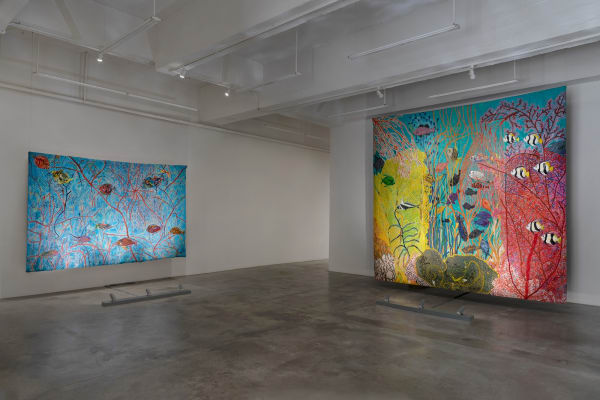
Pacita Abad: Underwater Wilderness
Exhibition Walkthrough Video August 11, 2024Video by Hyunjung Rhee | Narrated by Ami SheppeLearn More -
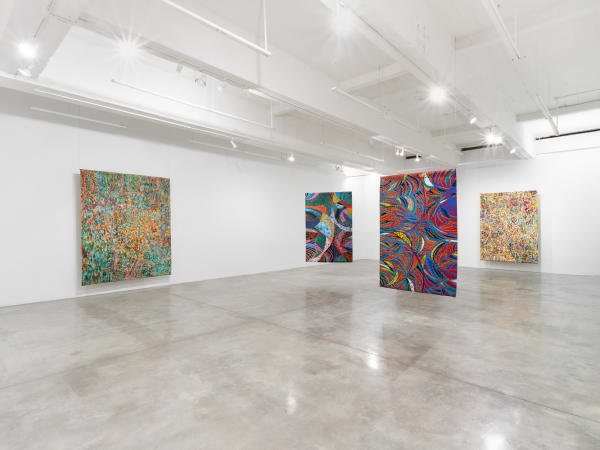
Pacita Abad: Colors of My Dream
Exhibition Video June 10, 2023Installation video of Pacita Abad: Colors of My Dream at Tina Kim Gallery (May 18–June 24, 2023). Video courtesy of Tina Kim Gallery. Video by Hyunjung RheeLearn More
-

Weekly News Roundup: Pacita Abad Archives Acquired by Stanford University
Art Asia Pacific May 30, 2025Stanford University has announced the acquisition and stewardship of Pacita Abad’s archives through a collaboration with the Cantor Arts Center, its affiliated Asian American Art...Learn More -

Artist Pacita Abad Archives Going To Stanford University
Forbes May 29, 2025The Cantor Arts Center and the Department of Special Collections at Stanford University Libraries today announced the acquisition of the Pacita Abad Archives. The vast...Learn More -

Stanford University acquires Filipina American artist Pacita Abad’s archive
The Art Newspaper May 29, 2025In Pacita Abad’s lifetime, the Filipina American artist made over 5,000 works—influenced by her travels in more than 60 countries—and exhibited in more than 250...Learn More -

How Art Basel Hong Kong is reclaiming overlooked artists’ legacies
South China Morning Post March 28, 2025Art Basel Hong Kong is back with its gargantuan offering of contemporary art by known and rising artists from the region and beyond. Among the...Learn More -

Monumental artworks revive ancestral traditions at Art Basel Hong Kong
Art Basel March 11, 2025‘There’s been a huge move to material practice and a real shift to recognizing Indigenous sovereignty,’ says Alexie Glass-Kantor, the curator of the fair’s sector...Learn More -

These 5 Women-Led Galleries Are Championing Overlooked Women Artists
Artsy March 3, 2025The art world has long operated under a patriarchal gaze, often sidelining the contributions of women whose accolades, if recognized, often arrive decades late. The...Learn More -

Homecoming: The art of Pacita Abad comes home to the Metropolitan Museum of Manila
Daily Tribune December 29, 2024The exhibition Pacita Abad: Philippine Painter opened recently at the Metropolitan Museum of Manila’s (The M) new home in Bonifacio Global City in Taguig City,...Learn More -

Meet 7 Artists Who Stole the Spotlight at the 2024 Venice Biennale
Artnet December 23, 2024They don’t call the Venice Biennale the art-world olympics for nothing. Even making it to half of the pavilions and collateral exhibitions is a serious...Learn More -

Best New York City Art Shows of 2024
Hyperallergic December 12, 20242024 was a bustling year for art in New York, with blockbuster exhibitions at museums, museum-level shows at galleries — especially a few new, nearly...Learn More -

Venice Biennale is over, but its stars can be found in Miami
The Art Newspaper December 4, 2024The 60th Venice Biennale ended on 24 November, but fairgoers in Miami are feeling its influence this week. Stands at Art Basel Miami Beach feature...Learn More -

Pacita Abad exhibition to open at the Metropolitan Museum of Manila
adobo magazine November 24, 2024Pacita Abad: Philippine Painter is a new exhibition opening on November 28, 2024 at the Metropolitan Museum of Manila (The M Museum) that takes a...Learn More -

‘Pacita Abad’ is a kaleidoscopic retrospective of the late artist’s work
stir world November 1, 2024The Art Gallery of Ontario (AGO) in Canada is currently presenting Pacita Abad , the Canadian leg of the first major retrospective by the eponymous...Learn More -

Venice Stars Dominate the Opening of Frieze London, But the Fair’s Controversial New Layout Is the Real Buzz
artnet October 9, 2024Facing up to the competition from Paris, Frieze London is doing what it does best: championing the new in contemporary art by giving its layout...Learn More -

Toronto Best Bets: October 8-14 —Art Month, Tynomi Banks, Halloween Events, & More
She does the city October 8, 2024As we move further into autumn, Toronto is winding down from Nuit Blanche and revving up for even more art, burlesque and Halloween festivities. Delight...Learn More -

‘Chances of Contact: Contemporary Prints from the Philippines and Singapore’: A masterful curation organised by STPI and The M
Tatler October 7, 2024In celebration of the 55th anniversary of the Philippines and Singapore’s diplomatic relationship, esteemed curator, academician, and critic Patrick Flores mounted an exhibition that brings...Learn More -

Raphael Fonseca's Top Picks from Frieze Viewing Room
Frieze October 7, 2024The Curator from Denver Art Museum selects works at Frieze London and Frieze Masters 2024, from Pacita Abad to Oren Pinhassi. Pacita Abad, Masquerade ,...Learn More -

6 Shows to See in Seoul During Frieze
ARTnews September 6, 2024As the third edition of Frieze Seoul heads into its final day today, many international visitors are likely already on their way home. Some may...Learn More -

The Best Booths at Frieze Seoul, From a Christ-Like Justin Bieber to a Metaphor for Fair Fatigue
ARTnews September 4, 2024In the press, there’s always a lot of ink spilled over a fair’s inaugural edition: Will it make the big splash it needs to in...Learn More -

She expanded consciousness with her exuberant use of colour. A bold new AGO show spotlights an underrated artist’s singular career
Toronto Star September 2, 2024The AGO’s retrospective of Pacita Abad — a standout show of the fall art season in Toronto — is the first major retrospective dedicated to...Learn More -

The Chelsea Art Walk
Photobook August 25, 2024Once per year, select galleries in Chelsea participate in the annual Chelsea Art Walk. For two hours, anyone interested in the ever-evolving art scene of...Learn More -

The Charismatic Vitality of Pacita Abad’s Trapuntos
The New Yorker August 23, 2024The Filipina artist Pacita Abad —who visited at least sixty countries, learning from Afghan embroidery, Mexican muralism, Javanese dyeing, Sri Lankan masks, and Pakistani quilts—makes...Learn More -

How Pacita Abad Wove a Multicultural Tapestry of Humanity
Observer August 20, 2024In recent years, there has been a significant resurgence of interest in women’s textile practices. No longer confined to the undervalued realm of craft, they...Learn More -

Pacita Abad Retrospective Headed to Toronto
Ocula August 16, 2024The eclectic artist Pacita Abad received her first retrospective last year, organised by the Walker Art Center in Minneapolis, where it was first shown. The...Learn More -

Pacita Abad, MoMA PS1 review — the joy of colour and a magpie instinct
Financial Times August 13, 2024Pacita Abad’s giant artworks have staged a friendly takeover of MoMA PS1 in New York. They’ve infiltrated the ordinarily gloomy galleries, animated the walls and...Learn More -

Pacita Abad, Larger Than Life
ArtReview August 13, 2024Inspired by scuba dives off the Philippine coast, Abad paints an underwater world at once wild and interdependent In the darkened gallery, seven monumental padded...Learn More -

Stitch by Stitch, Pacita Abad Crossed Continents and Cultures
The New York Times August 1, 2024About a year before she died of cancer, in 2004, at the age of 58, the artist Pacita Abad and a team painted a pedestrian...Learn More -

What I'm Looking At: Museum Quality Malcolm Morley, Borna Sammak's Beautiful Scenesters, and more
Artnet July 25, 2024“What I’m Looking At” a column where I digest art worth seeing, and whatever else is on my mind. Below, thoughts on what’s in the...Learn More -

Shows to See in July 2024
Art Asia Pacific July 12, 2024Pacita Abad Underwater Wilderness Tina Kim Gallery New York Jun 27–Aug 16 “Underwater Wilderness” presents eight monumental trapuntos (stuffed quilting) by the late Filipina American...Learn More -

Pacita Abad Sees the Soul of an Artifact
MOMUS July 5, 2024Pacita Abad, the Filipina artist who roamed the world like a traveling bard, was twenty-four when she left home in 1970. By the time she...Learn More -

Pacita Abad’s Plunge into the Deep
Ocula June 27, 2024Dorian Batycka described Pacita Abad in 2020 as 'undoubtedly a world citizen, her legacy resonating far beyond the place where she was born'. But only...Learn More -

Tina Kim Illuminates the 6 Best of Basel in June
Whitewall June 14, 2024The illustrious Tina Kim founded her namesake gallery in 2001 in New York, and ever since then has been a guiding light in the international...Learn More -

What Not to Miss During Frieze New York
W Magazine May 3, 2024Something about this year’s edition of Frieze New York put us in mind of Miami and Palm Beach palaces, where chunky colorful work thrives alongside...Learn More -

Seven Artists with Unconventional Art Journeys at Frieze New York
FRIEZE May 2, 2024The 2024 edition of Frieze New York spotlights alternative journeys into art, as championed by galleries such as Ortuzar Projects , Andrew Edlin Gallery and...Learn More -

5 Standouts From the 2024 Venice Biennale
Vogue April 22, 2024Having been beguiled by Pacita Abad’s just-opened exhibition at MoMA PS1, I was delighted to spy a cluster of her works toward the beginning of...Learn More -

Overlooked During Her Lifetime, Filipino American Artist Pacita Abad Has Suddenly Become a Global Star
VOGUE April 19, 2024It’s easy to see why Pacita Abad’s work resonated with Faith Ringgold. Like her American counterpart, Abad—a native of Basco, Batanes, in the Philippines—was also...Learn More -

Pacita Abad Threaded Together Bold Solidarities
The AMP April 19, 2024Tucked away in a corner of MoMA PS1’s third floor exhibition space, a digitally restored interview with the late artist Pacita Abad loops on a...Learn More -

Double Vision: Artists at the 60th Venice Biennale and Frieze New York 2024
FRIEZE April 18, 2024As the art world descends on Venice, discover the artists featuring prominently during the 60th Biennale who will also be bringing work to Frieze New...Learn More -

Pacita Abad Wove the Women of the World Together
The Nation April 18, 2024At the end of the Pacita Abad retrospective at the Walker Art Center in Minneapolis last summer, there hung, unassumingly, her most monumental work: a...Learn More -

Pacita Abad Stitched the Immigrant Experience into Her Embroidered Paintings
Artsy April 5, 2024At 24 years old, Pacita Abad faced the wrath of Filipino dictator Ferdinand Marcos head-on. In 1970, her family home was machine-gunned in the middle...Learn More -

Highlights from Art Basel Hong Kong 2024
ArtAsiaPacific April 2, 2024AAP editors share their thoughts on a number of works from the first large-scale, in-person edition of Art Basel Hong Kong since 2019. Solo showcases...Learn More -

Change is in the Air I-V
BOMB Magazine March 15, 2024Pacita Abad created the series Change is in the Air while living in Indonesia in 1995, twenty-five years after fleeing the Philippines and the oppression...Learn More -

Frieze L.A. 2024: Highlights From the Fair
Women's Wear Daily March 3, 2024“We’re very excited to be in L.A.,” said art dealer and gallery owner Tina Kim, who’s based in New York. Known for introducing Asian artists...Learn More -

Inside Frieze Los Angeles, California's Hottest Art Fair
Maxim March 1, 2024Pioneering powerbroker Tina Kim is sharing an extensive array of works from her notably intellectual roster all weekend. Disparate artistic approaches harmonize on the common...Learn More -

Pacita Abad Invited to the 60th International Art Exhibition of La Biennale di Venezia
January 31, 2024Tina Kim Gallery is pleased to announce that Pacita Abad (US, b. Philippines, 1946-2004) is invited to Biennale Arte 2024, curated by Adriano Pedrosa. Stranieri...Learn More -

Fog Design + Art Fair Celebrates 10 Years With Swift Sales and Artist-First Programming
Artnet January 19, 2024FOG Design+Art Fair has hit its 10-year milestone—and its stride. The fair opened on January 18 at San Francisco’s waterfront Fort Mason Center to a...Learn More -

In San Francisco for FOG? Don't Miss These 7 Exhibitions Around the City
CULTURED January 17, 2024Anyone who has weaved through endless rows of booths at an art fair knows there is limited exhibition space in even the largest of stalls....Learn More -

Announcing 2024 Exhibitions
January 5, 2024Tina Kim Gallery is proud to announce our 2024 programming. Our spring season begins with a solo exhibition of Amsterdam-based artist Jennifer Tee , whose...Learn More -

See Inside the Revelatory Retrospective for Filipino American Artist Pacita Abad
Artnet News January 2, 2024In 1970, 24-year-old Pacita Abad left her home in the Philippines, fleeing political persecution after leading a student protest against the Marcos regime. She was...Learn More -

Pacita Abad
E-Flux December 22, 2023To discuss the life of Pacita Abad is to enumerate the diverse places to which she traveled (some sixty countries across six continents), her expansive...Learn More -

Filipino artist Pacita Abad’s ‘vibrant spirit of rebellion’ lives on at SFMOMA
SF Chronicle November 14, 2023Color is everywhere in the San Francisco Museum of Modern Art’s exuberant Pacita Abad exhibition, the first major career retrospective of the peripatetic Filipino artist....Learn More -

Pacita Abad A Revelation At San Francisco Museum Of Modern Art
Forbes November 3, 2023In the opening scene of Season 3, Episode 1 of Hulu’s “Only Murders in the Building,” an aging unknown Broadway hopeful played by Meryl Streep...Learn More -

San Francisco Museum of Modern Art celebrates first retrospective of artist Pacita Abad
Artdaily October 22, 2023SAN FRANCISCO, CA .- The San Francisco Museum of Modern Art is carrying out the first retrospective of Pacita Abad. Featuring more than 40 major...Learn More -

At SFMOMA, Pacita Abad’s Painted Textiles Stare Right Back
KQED October 20, 2023It’s fitting that the San Francisco Museum of Modern Art’s Pacita Abad retrospective opens with a kind of monumental celebratory bunting. 100 Years of Freedom:...Learn More -

The Decades-Strong Path of Color Set Ablaze By Pacita Abad
Vogue September 17, 2023Pio Abad reflects on the exuberant work of his aunt, the Batanes-born, world-traveling artist Pacita Abad, whose immense retrospective blazes its way across North America....Learn More -

Pacita Abad
ArtAsiaPacific September 1, 2023The first international retrospective of the late Pacita Abad (1946–2004), curated by Victoria Sung with Matthew Villar Miranda, was as celebratory as it was studious....Learn More -

The 100 Greatest New York City Artworks, Ranked
Artnews August 29, 2023Pacita Abad, L.A. Liberty , 1992 Of the many representations of the Statue of Liberty throughout art history, few look quite like Pacita Abad’s L.A....Learn More -

A 350-Page Tribute to Pacita Abad’s Boundless Art
Hyperallergic August 2, 2023What is most remarkable about the life and work of Filipina artist Pacita Abad? The expansive catalogue that accompanies the artist’s career-spanning survey exhibition at...Learn More -

Pacita Abad’s Stitching Traverses the Globe
FRIEZE July 7, 2023I had to resist the urge, walking through Pacita Abad’s retrospective at Walker Art Center, to wrap myself in one of the artist’s colourful, hand-embroidered,...Learn More -

Taking Liberty
Artforum June 1, 2023The Statue of Liberty is the apex of national mythmaking, a bloated bronze symbol standing watch over New York Harbor, where it broadcasts a promise...Learn More -

25 Pathbreaking Asian American Artists Whose Names You Need to Know
ARTnews May 27, 2023As Asian American and Pacific Islander History Month winds down, it’s important to note how many AAPI artists, architects, collectors, and activists have changed the...Learn More -

Pacita Abad: Dreams in color
Inquirer.net May 22, 2023NEW YORK — I don’t remember exactly where I first met the artist Pacita Abad, whether in New York, Washington, or in Manila, nor the...Learn More -

Vivid Colors Erupt At Frieze, Large-Scale Abstract And Figurative Works By Women Artists Wow
Forbes May 18, 2023Abstraction wrangles with representation, as delicate flowers mingle with bold fruits floating on the textured canvas, guiding our eye on a joyous exploration of shapes...Learn More -

Six Gallery Shows to Catch in Chelsea After Frieze
ARTnews May 17, 2023Pacita Abad at Tina Kim Gallery For those unfamiliar with the prolific practice of the late Pacita Abad, this lush solo show at Tina Kim...Learn More -

Layered and Embellished Trapunto Paintings Exude Spirit in Pacita Abad’s First Retrospective
Colossal May 10, 2023Having created more than 5,000 paintings in her lifetime, traveled the world, and shown in over 200 exhibitions, Pacita Abad (1946-2004) was one of the...Learn More -

Coloring in the Margins: Pacita Abad
The New York Times April 25, 2023On a wintry March day in Minneapolis, a small group gathered underground to look at monumental and hyper-colored works of art. In the sprawling storage...Learn More -

‘Pacita Abad’ at the Walker Celebrates a Life Lived Globally
Racket April 14, 2023Pacita Abad hated white walls. So, for her retrospective exhibition at the Walker Art Center, the galleries have been painted: pale pink, golden yellow, deep...Learn More -

First-of-its-kind retrospective of Filipino artist Pacita Abad opens at the Walker
CBS News April 14, 2023MINNEAPOLIS -- Visitors to the Walker Art Center will soon experience a never-before seen exhibit highlighting the colorful work of a world-renowned artist. It's a...Learn More -

Pacita Abad’s Art of Excess
The Wall Street Journal April 7, 2023A peripatetic life and a more-is-more sensibility were the key ingredients in the career of textile artist Pacita Abad, whose monumental artworks broke down barriers...Learn More -

Lauren Haynes's Top 5 Works on Frieze Viewing Room
Frieze February 15, 2023The Queens Museum curator selects some of her favorites, including works by Pacita Abad, Betye Saar, Dyani White Hawk, Hana Ward and Anna Valdez. Pacita...Learn More -

7 Must-See Works to Seek Out at the ADAA Art Show, From Remedios Varo’s Surrealist Scenery to Pacita Abad’s Stunning Sun Goddess
Usa ART News November 3, 2022The Art Show, the annual art fair (and one of the originals), hosted by the Art Dealers Association, threw open its doors at the Park...Learn More -

What’s Showing in Seoul, September 2022
ArtAsiaPacific August 31, 2022Contemporary art’s global K-boom is circling back to Seoul starting this month. The big K-motion is being stirred by the arrival of Frieze Seoul ,...Learn More -

Frieze Debuts in Seoul, With Big-Name Galleries and a Hometown Spectacle
The New York Times August 30, 2022High-end art fairs have been giving themselves global brand extensions for years, and the latest one, Frieze Seoul, is among the more ambitious. Frieze —...Learn More -

Pacita Abad Estate Gets Gallery Representation Ahead of U.S. Retrospective
Artnews January 27, 2022Ahead of a major U.S. retrospective due to open in 2023, the estate of Pacita Abad , a pioneering Filipina artist whose work has become...Learn More -

Pacita Abad: World Citizen
Ocula November 24, 2021At the Jameel Arts Centre, located at Dubai's Jaddaf Waterfront, a new solo exhibition has opened featuring works by one of the Philippines' most prolific...Learn More -

Long Pushed to the Margins, Pacita Abad’s Art About the Immigrant Experience Gets Global Recognition
ArtNews April 15, 2021The story of the thousands of immigrants who passed through Ellis Island in New York during the late 19th and early 20th centuries is well-known...Learn More -

LOOK CLOSER: Understanding Pacita Abad's European Mask
Tate April 1, 2021'I have been very fortunate to spend most of my artistic career painting in the far-flung corners of the globe and my journeys have been...Learn More
























